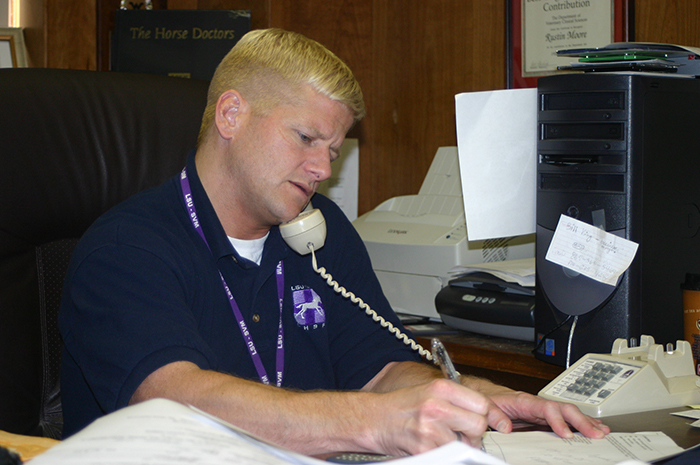Katrina at 20
20 heroic tales of people helping animals
as told to Sandra Sarr, LSU Vet Med strategic communications
Rustin Moore, dean, Ohio State University College of Veterinary Medicine

Dr. Rustin Moore on the phone following Hurricane Katrina. Dr. Moore created a helpline for horse owners to request assistance.
– Photo Credit: Dr. Rustin Moore
“In the chaotic days after Hurricanes Katrina and Rita made landfall on August 29 and September 24, 2005, I found myself in a role I hadn’t asked for—but couldn’t walk away from. I had just returned from visiting my parents in West Virginia the day after Hurricane Katrina made landfall and the timing was fortunate; another day and I might not have made it back for a week. A few days later, a call came: “We need you at the Lamar-Dixon Expo Center. There’s a group heading into New Orleans to rescue a few stranded horses.”
I drove straight there, still unsure why I was needed for just three horses. When I asked, no one answered. So, I stepped aside and let the team go. As I stood with those who remained, it became clear—no one was in charge, and without leadership, nothing would happen. I turned to the group and said, ‘If someone doesn’t step up and organize this, we’re not going to be successful.’
That wasn’t a pitch for the job. I already had one—as a faculty member, head of equine surgery, and director of the Equine Health Studies Program at LSU. But I jumped in anyway—head, heart, and hooves first.
Over the next ten weeks, we organized and commandeered one of the largest equine rescue operations in U.S. history. We set up a command center, mapped the locations of stranded animals, and coordinated hundreds of volunteers, veterinarians, and borrowed trailers to reach them. We rescued nearly 500 horses and hundreds more dogs, cats, pigs, goats, and other animals—reuniting most with their owners.
We worked around the clock, often planning missions into the early morning hours and deploying again at sunrise. The work was hard, exhausting, and at times heartbreaking—but it was necessary. There were horses and humans out there who, if we didn’t act, might not get help in time. Through grit, long hours, and a deep sense of duty, we didn’t just save animals—we built something far more enduring: trust, connection, and the reminder that compassion and collaboration can lead even in the darkest moments.
The scale of devastation was overwhelming—not just for the people, but for the animals who were left behind. At the Lamar-Dixon Expo Center, we witnessed horses arrive dehydrated, injured, and frightened, yet still fighting to survive. What struck me most was how quickly a sense of hope returned when they were given food, water, and gentle care. Leading that rescue operation wasn’t just about saving lives—it was about restoring dignity and compassion in the amid chaos, and proving that even in the worst of times, humanity can rise to meet the needs of every living being. This was an enriching, life-changing experience that I would never trade, but one that I would not care to repeat or wish upon anyone else. I am so thankful for the opportunity to have met so many dedicated and compassionate people who came together around a cause. I continue to stay in touch with many of them 20 years later.
We reshaped large-animal disaster response nationwide. Drawing on the massive rescue, sheltering, and treatment effort after the storms, we detailed the creation of a dedicated Equine Branch within the Incident Command System—complete with an organizational chart and communication flow that became a national model. Our analysis underscored the value of integrating animal welfare into disaster planning from the outset, supported by cross-disciplinary training for veterinarians, emergency managers, and responders. The report became a cornerstone of veterinary disaster curricula, informed Louisiana’s post-Katrina guidance for horse owners, and spurred the American Association of Equine Practitioners to establish the Equine Disaster Relief Fund.
The multi-agency sheltering operation at Lamar-Dixon now serves as a benchmark for coordinated large-animal care, proving that organized, animal-inclusive command structures can turn chaos into coordinated, lifesaving action.”